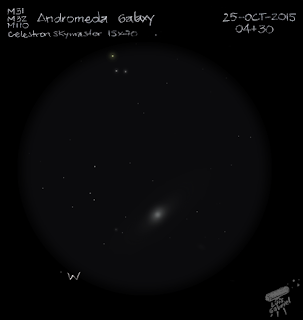Comparison: Bortle 6 vs. Bortle 4 sky
This summer was a long
period of clouds and rain so I did not have a chance to look at the sky. I probably
had only 2 or 3 clear nights during the whole summer so I was basically
dedicated to practicing the piano, my other hobby. Now that the rainy season is
over, I am glad that once again I have something to share in the blog.
As soon as the clear nights
started I began to think about completing my 80 Messier sketches. Why 80? I am
a member of AstronomyForum.net and they encourage members to reach certain
goals like 30, 70 (or 80) and 110 Messier seen, sketched or photographed. I already
completed the 30 Messier Sketch Award so I wanted to go for the next step: the
80 Messier Sketch Award.
With only two Messiers left
and using my 15x70 binoculars on a Bortle 5-6 sky I only had a few options to
reach the goal: M56 (GC in Lyra), M104 (Sombrero galaxy) or M72 (GC in Aquarium).
The night of the 6th of
November I went out of my apartment determined to reach my 80 sketches. M56 was
just above the glimmer of the northern sky therefore I couldn’t see it. I
thought I might have more luck with M72, a globular cluster that I had unsuccessfully
tried before. I was using Stellarium mobile to do the star hopping and with not
as many stars as the PC version I thought I had found it as well as M73, an asterism
located about 1°20’ of
M72.
I could barely see a star
southwest of HIP 103151 and because I did not see that star in my tablet I
thought it could be M72. Later on my computer,
I found out that there was star of magnitude 9.40 that was very close to M72 so
what I had seen was that star and not the globular cluster. The same happened
to M73, I misplaced two stars of magnitude 9.25 and 8.85 and I thought one of
them could be M73.
I had not seen any of the
DSOs so I felt a little disappointed with my location. Even with a perfect
seeing and transparency, there was no way I could see those objects with a
bright background sky like the one above my apartment complex.
The good news is that
Lijiang is a small city surrounded by mountains, looking at the map the blue
and green areas, where the sky is much darker, are quite near enough to visit
in a night. I live just in the edge of an Orange area (red pin), Bortle 5-6 so
my views of the North West sky are not so good. Looking south from my place is far
more pleasant as the sky is notoriously darker.
Two nights later, I went to
one of the edges of the city to try my luck with M72. I drove southwest from my
apartment and about 4 miles later I found myself in a village with no lights on
and the sky seemed pretty dark especially in the Northwest direction (blue
pin).
Less than 5 miles from my
house, I was enjoying a Bortle 4 sky (Green-blue transition area). It was dark
enough to allow me see the Milky Way in Cygnus and Cassiopeia. I unpacked the
binos and the tripod and started to search. I clearly saw M56 as a round smudge
and before I started to sketch I checked out M72. This time I found it and not
only that but I also saw a weak spot where M73 should be located. That asterism had a stellar appearance with
just a little of fuzziness around. Without doubt I knew that it was M73 and
both Messier fitted in my binoculars field of view; definitely, good news. I
could fit both Messiers in one sketch and then I would finally get the M80
sketch award.
 Without
doubt, what a nice combination: a pretty dark sky and a pair of binoculars.
There is still more to watch with my binos, but I think it’s time to go to the
next step: a telescope. Of course, they will be my grab and go optics and a
nice tool besides the scope.
Without
doubt, what a nice combination: a pretty dark sky and a pair of binoculars.
There is still more to watch with my binos, but I think it’s time to go to the
next step: a telescope. Of course, they will be my grab and go optics and a
nice tool besides the scope.
Clear
skies and I wish you a happy thanksgiving!!!
LG
Edited by Jennifer Steinberg
(editor in chief)
SOURCES





